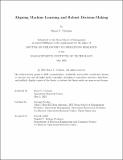| dc.description.abstract | Machine learning (ML) has become increasingly ubiquitous across many applications worldwide, ranging from areas like supply chain to personalized pricing, recommendations, and more. These predictive models are often used as tools to inform operations and decision-making, with the potential to revolutionize decision-making. The main key question this thesis aims to address is: How can we make ML methods aware of their downstream impact on the full decision-making process? As a result, we focus on developing methods to align AI with real-world objectives in order to make efficient, safe, and robust systems.
This thesis is split into three chapters focusing on different aspects of this problem. In Chapter I of this thesis we address the heavy computational complexity of existing methods. We present a meta-optimization machine learning framework to learn fast approximations to general convex problems. We further apply this within an end-to-end learning framework which trains ML models with an optimization-based loss function to minimize the decision cost directly. This meta-optimization approach allows us to tackle problem sizes that were intractable using approaches from the previous literature. Furthermore, this work establishes analytically that this learning approach guarantees fast convergence to nearly-optimal solutions. Through this chapter it is shown that the proposed approach consistently scales better in terms of runtime as problem size increases, being 2 to 10 times faster for various problems while retaining nearly the same accuracy.
In Chapter II we focus on the robustness problem, to make decisions that protect against worst-case scenarios as well as to noise in the data. Traditional robust optimization methods tackle this issue by creating uncertainty sets for each observation, aiming to minimize costs in worst-case scenarios. However, these methods assume the worst-case scenario happens at every observation, which can be too pessimistic. We propose a new approach that avoids constructing uncertainty sets and links uncertainties across the entire feature space. This allows for robust decision-making without assuming worst-case scenarios at every observation. Our approach integrates robustness with a concept of learning stability, proving that algorithms with a stability property inherently produce robust solutions without explicitly solving the robust optimization problem. This chapter finally tests the framework on a variety of problems such as portfolio optimization using historical stock data, inventory allocation and electricity generation using real-world data, showing significant improvement in terms of robustness and competitive results in terms of the average error relative to existing literature.
Finally in Chapter III we consider the endogenous setting where decisions we take affect outcomes, like pricing and assortment optimization where decisions (like price) affect demand. In the end-to-end spirit, this research introduces an approach to jointly predict and optimize in this setting which learns a prediction aligned with expected cost. We further introduce a robust optimization decision-making method that can account for uncertainty in ML models --- specifically by constructing uncertainty sets over the space of ML models and optimize actions to protect against worst-case predictions. We further prove guarantees that our method can capture near-optimal decisions with high probability as a function of data. We also introduce a new class of two-stage stochastic optimization problems to the end-to-end learning framework that can now be addressed through our framework. Here, the first stage is an information-gathering problem to decide which random variable to ``poll'' and gain information about before making a second-stage decision based off of it. We present several computational experiments for pricing and inventory assortment/recommendation problems. We compare against existing methods in bandits and offline reinforcement learning, showing our approach has consistent improved performance over these. | |
